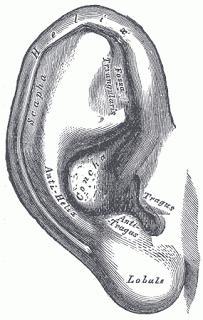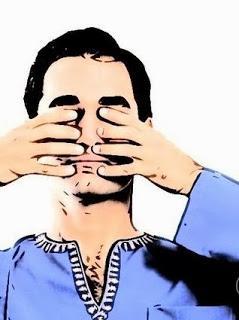Recently in a post (Pranayama for Everyone), I wrote about the "buzzing bee breath," Bhramari. I taught a simplified version so that people could get used to it, and feel this practice's almost immediately palpable soothing effects. A reader wrote in with a question about the mudra (in this case meaning a hand position) often taught as part of the practice. So today, I'll teach two more advanced versions of Bhramari, in which the hands are used to deepen the effects.
The fifth limb of the eight-limbed path of yoga as taught by Patanjali is pratyahara, which I like to translate as "turning of the senses inward." Most of us living in the modern world lead lives of nearly constant sensory overload. Phones ring and buzz, TVs blare in the background, and even gas pumps impose video commercials on us. It's hard to escape the visual and aural onslaught. A beautiful antidote is Bhramari, particularly when it's taught with Shanmuki mudra.
Shanmuki mudra is designed to close the gates of perception: the ears, eyes, nose and mouth. It noticeably heightens the power of Bhrmari to internalize the awareness, and you'll notice that the buzzing sounds louder. But before we try the full mudra, let's begin with a modified version.
Bhramari with Modified Shanmuki Mudra
Sit in a comfortable seated position, with the spine upright but relaxed. Place the pad of each index finger on its respective ear, on the tragus, the skin-covered tab of cartilage near the front of the ear, just above the earlobe.
 Using gentle pressure, use the tragus to block sound from entering the ear. Try a few rounds of Bhramari, making a medium-pitched buzzing sound on each exhalation. Compare the effects when you occlude the ear and when you lift the fingers.
Using gentle pressure, use the tragus to block sound from entering the ear. Try a few rounds of Bhramari, making a medium-pitched buzzing sound on each exhalation. Compare the effects when you occlude the ear and when you lift the fingers.
Bhramari with Full Shanmuki Mudra
In full Shanmuki mudra, instead of the index fingers, use the tips of the thumbs to push down the tragus. The index fingers exert mild pressure on the upper, inner eyelid. Be careful not to press too hard. You want the pressure to feel soothing to the eyes. The middle fingers are placed on either side of the nose, above the nostril and below the nasal bone. You'll know you're in the right place, when gentle pressure on the fingers slightly occludes the passage of air through each nostril. The ring and pinky fingers are placed on either side of the midline just above and below the lips, respectively.
 Once you've successfully got the mudra in place, try anywhere from one to five minutes of Bhramari, then lower the hands. You may want to continue to sit in meditation for a few minutes after you finish.
Once you've successfully got the mudra in place, try anywhere from one to five minutes of Bhramari, then lower the hands. You may want to continue to sit in meditation for a few minutes after you finish.Therapeutic Benefits
Bhramari very quickly shifts the autonomic nervous to parasympathetic dominance. The practice can be useful for anyone with a stress-related condition, and particularly when demands and sensory input make you feel overwhelmed. It may be especially useful conditions like anxiety and insomnia, and even autoimmune conditions.
If you're using Bhramari to reduce symptoms of a cold or sinus infection, either skip Shanmuki mudra entirely or only use the modified version above. Ditto if you feel claustrophobic with the mudra.
While high blood pressure can have multiple causes, many cases of so-called "essential hypertension" (which make up the vast majority of cases), are characterized by heightened activation of the stress response. Thus the regular, ideally daily, practice of Bhramari and other calming yoga techniques may be very effective both at keeping your blood pressure down, and helping reduce it if it's high.
Note from Nina: For more about the yogic approach to high blood pressure, please check out Timothy's upcoming webinar on Yoga U, at an online educational resource. It will be held on two consecutive Saturdays at 12:30 eastern and 9:30 pacific time, starting November 30, 2013. Click this link for more information.

